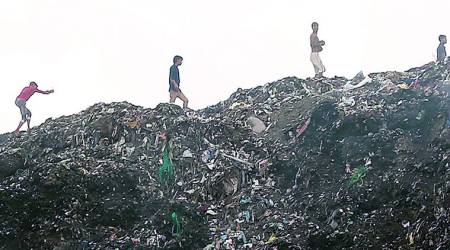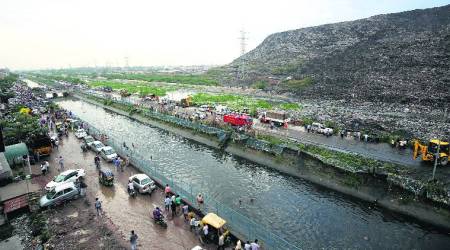 At the Ghazipur landfill on Saturday, a day after two people died there. Gajendra Yadav
At the Ghazipur landfill on Saturday, a day after two people died there. Gajendra Yadav
No garbage will be dumped at the Ghazipur and Bhalswa landfills from Saturday. But the question of where to dump the 6,500 tonnes of garbage, produced every day in North and East Delhi, remains largely unanswered. A day after two people died when a part of the Ghazipur landfill came crashing down, Lieutenant Governor Anil Baijal directed the closure of the landfill site. Not long after, Chief Minister Arvind Kejriwal said the order had been extended to the Bhalswa landfill. North MCD mayor Preety Agarwal confirmed the development.
On Saturday, the L-G chaired an emergency meeting with officials of the EDMC, NHAI and DDA in the afternoon, and directed that “no more dumping of solid waste… would take place at the Ghazipur landfill site”. Instead, waste would be sent to an “alternative site”, he said. Initially, Bhalswa landfill was picked as the “alternative site” — but was quickly junked after criticism from the Delhi government. The Bhalswa site was commissioned in 1994, started overflowing in 2003 and has been operating without certification from the Delhi Pollution Control Committee for a decade.
In 2016, the 40-acre landfill was ablaze for a week, spiking air pollution and leading to health complaints from locals. Further, a government committee report in 2016 deemed the landfill a “fire hazard due to high levels of methane gas emissions, as well as an environmental and health hazard”, officials said. Around 5 pm, Kejriwal rushed to meet the L-G. After the meeting, he confirmed that the Bhalswa landfill, too, had been closed and said, “Fresh landfill sites have been identified by DDA in North and East Delhi.”
While a part of the waste from North Delhi might end up at Delhi’s first “scientifically” engineered landfill at Narela-Bawana — the only one with capacity left — most of the garbage is likely to end up at a 30-acre plot in Rani Khera, officials said. The land was initially meant for Delhi’s first modern pig slaughterhouse and pork processing plant.

But the North corporation admitted that the plot, which still awaits approval from the Central Pollution Control Board, is a “temporary solution”. “The meeting (on CPCB clearance) is scheduled for Sunday,” Agarwal said. The mayor also sought a status report on the Bhalswa landfill, admitting that it “posed a similar threat”. She said necessary action had to be taken “to avoid a repeat of Ghazipur”, while adding that the problem was of finding “alternate space”.
Meanwhile, officials at the third major landfill, in Okhla, said the landfill — commissioned in 1996, overflowing since 2003-2004 and with a height of 48.5 metres — was “safe” due to “care taken to ensure that slopes remain gradual and not steep”. Officials said construction of a new landfill requires at least six months. “Assuming the land is identified and no one — environmentalists or residents — has an issue, the soil has to be prepared to prevent leachate, and contractors need to be roped in,” a North MCD official said.

